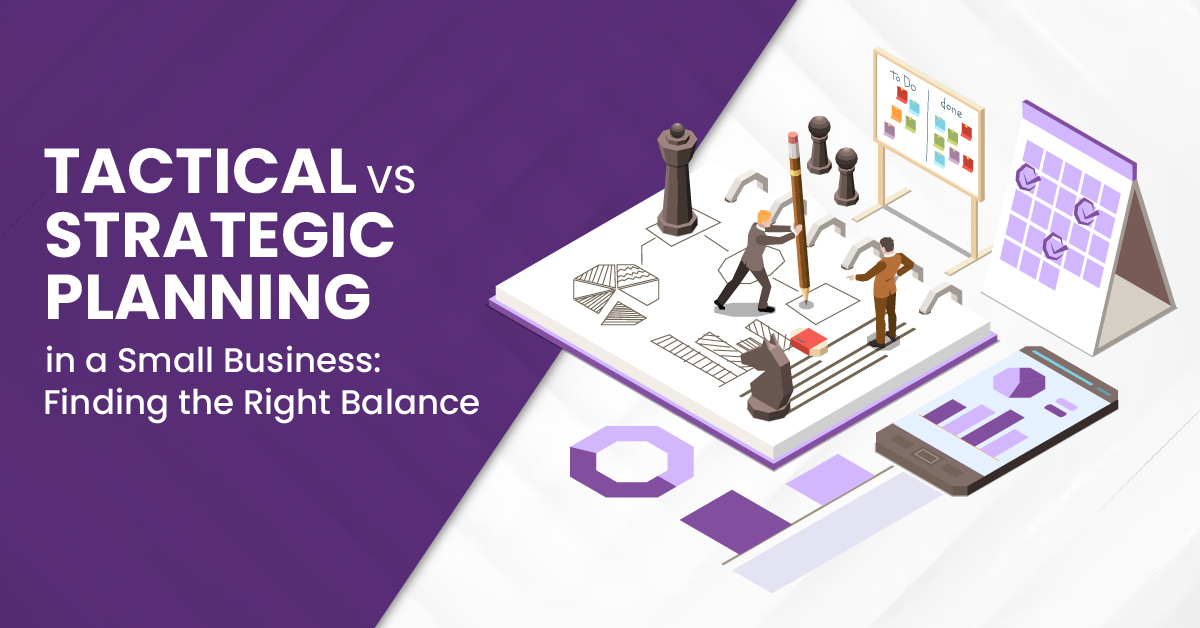Running a small business is a balancing act—and your planning style can make or break your momentum. Many entrepreneurs get caught up in daily tasks (tactical planning) and forget to look at the big picture (strategic planning), or vice versa.
The truth is, you need both to grow smart and sustainably. In this blog, we’ll break down the difference between tactical and strategic planning, why both are essential, and how to align them to drive real business growth.
What is the Difference Between Strategy and Tactics in a Small Business?
What is Tactical Planning?
Tactical planning refers to developing specific actions, strategies, and initiatives to achieve short-term goals and objectives within an organization.
It involves making detailed decisions and allocating resources to optimize performance and accomplish immediate tasks. Tactical planning focuses on the practical steps necessary to support the overall strategic direction of the organization.
For Example:
A D2C company may engage in tactical planning by launching a targeted social media advertising campaign during a peak shopping season, optimizing its website for a smoother shopping experience, and offering limited-time discounts to increase sales.
If you need help with designing your social media campaigns, you can turn to Design Shifu. We offer unlimited graphic designs for a flat monthly fee and provide white labeling solutions to creative agencies and businesses, should you require assistance with client work. Explore our subscription plans here to get started.
What is Strategic Planning?
Strategic planning involves setting long-term goals and creating a comprehensive plan to achieve the company’s vision and objectives.
It encompasses analyzing the internal and external environment, identifying strengths, weaknesses, opportunities, and threats (SWOT analysis), and formulating strategies to guide the organization’s direction over an extended period.
For Example:
A D2C brand might engage in strategic planning by envisioning becoming a leading sustainable fashion brand globally within the next decade.
They could plan to invest in eco-friendly materials, establish partnerships with ethical manufacturers, and expand their market reach through international collaborations and online platforms.
Strategy vs Approach vs Tactic for a Small Business

Now, that we have understood strategy and tactics, let’s understand strategy vs approach vs tactic using an example:
Think of strategy as the big plan for a small business, like deciding where to go on a road trip.
The approach is like choosing the best route to get there, considering your car’s strengths and the roads available.
Tactics are the specific actions you take during the trip, like turning left or right, to stay on track and reach your destination as planned. Strategy is the what, approach is the how, and tactics are the small steps you take to get there.
Tactical vs Strategic Planning: When to Do What?
Understanding when to implement tactical and strategic planning is essential for optimizing a business’s performance and growth.
When to do Tactical Planning?
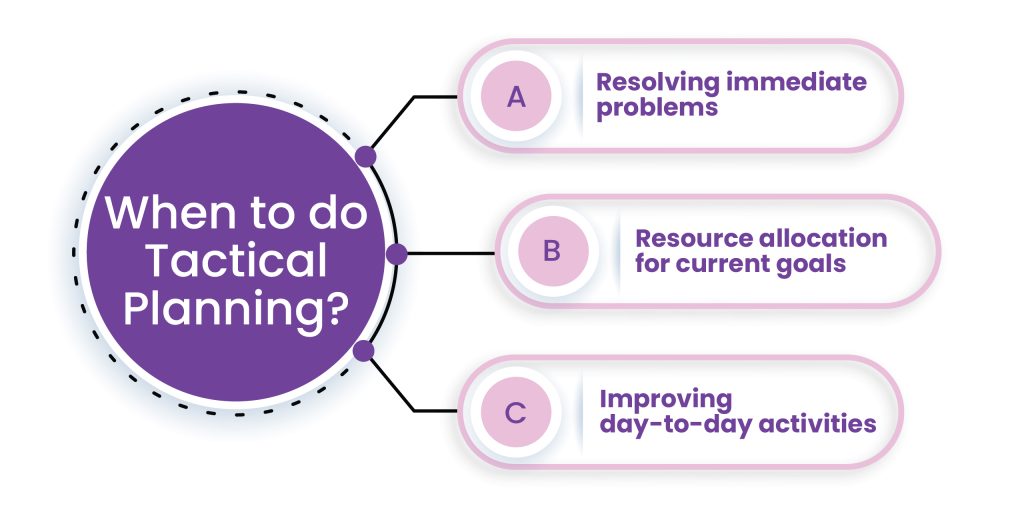
a. Resolving immediate problems:
This becomes vital when the business needs to respond quickly to unexpected challenges or opportunities. It allows for swift decision-making and adaptation to ensure short-term success.
b. Resource allocation for current goals:
Tactical planning is key when the primary focus is on efficiently utilizing existing resources to achieve specific short-term goals. It involves allocating resources based on immediate needs and capacities.
c. Improving day-to-day activities:
Tactical planning ensures that you streamline day-to-day operations, improving productivity, and addressing routine business functions for better efficiency.
When to do Strategic Planning?
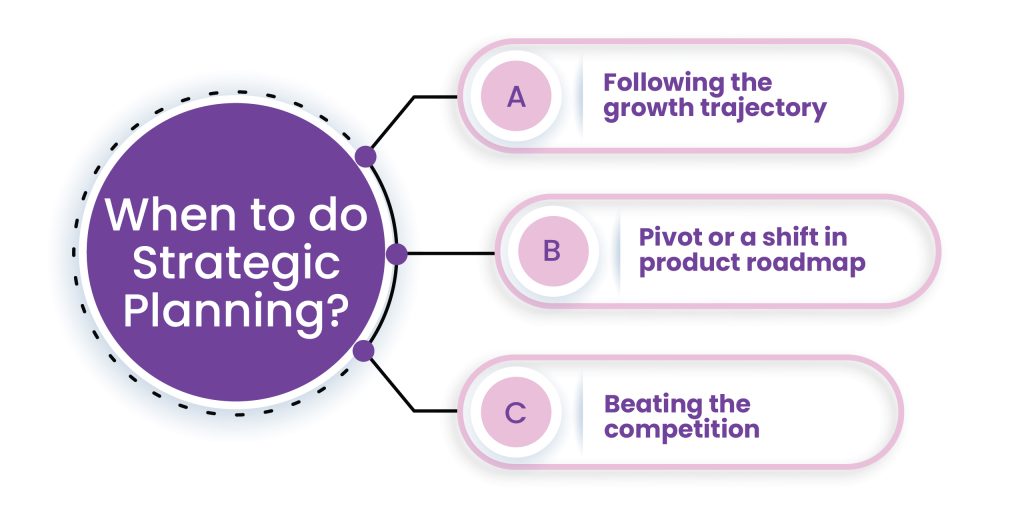
a. Following the growth trajectory:
Strategic planning is indispensable when the business aims to achieve sustainable long-term growth, expand into new markets, or diversify its offerings.
b. Pivot or a shift in product roadmap:
This becomes useful when introducing significant changes, innovations, or shifts in business models necessitates strategic planning to ensure seamless transitions and successful implementation.
c. Beating the competition:
When striving to gain a competitive advantage or establish market leadership, strategic planning is vital. It helps you assess the market, analyze competitors, and formulate strategies for long-term success.
How to Develop a Tactical Plan for Your Small Business?
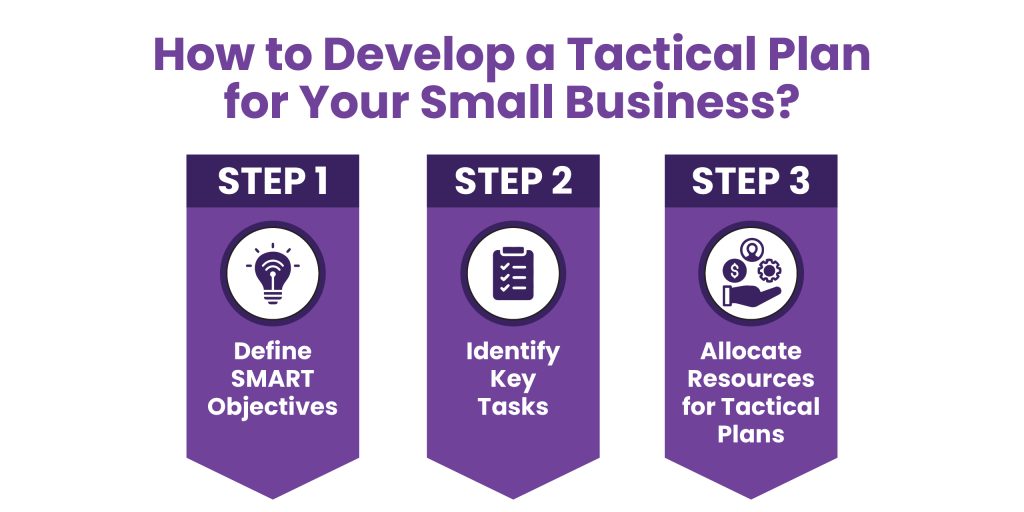
Step 1: Define SMART Objectives
1. Setting SMART Objectives
- Specific: Clearly define what you want to achieve with specific details.
For instance: Increase the sale of product X by 10% within the next three months.
- Measurable: Establish concrete metrics to track progress and success.
Example: Track newsletter signups through paid ad campaigns.
- Achievable: Set goals that are challenging but attainable within your current resources.
Example: Ensure a 15% increase in website conversion rates by optimizing existing marketing campaigns.
- Relevant: Ensure the objective aligns with your overall business goals and mission.
For example: Increasing website traffic aligns to expand the online customer base.
- Time-bound: Set a clear timeline to create urgency and focus.
Example: Achieve a 20% increase in website traffic by the end of the next quarter.
Step 2: Identify Key Tasks
List the specific tasks needed to achieve each SMART objective.
Example:
- Optimize website for search engines (SEO).
- Implement targeted online advertising campaigns.
- Improve the user experience on the website for increased engagement.
Step 3: Allocate Resources for Tactical Plans
1. Assessing Available Resources:
Identify the resources at your disposal, including human resources, budget, technology, and tools.
Example:
Human Resources: Marketing team members and web developers.
Budget: $5,000 allocated for marketing efforts.
Technology: Existing website and analytics tools.
2. Allocating Resources Efficiently:
Allocate resources based on the key tasks identified, ensuring optimal utilization.
Example:
- Allocate 30% of the budget for targeted online advertising campaigns.
- Allocate 40% of the budget for website optimization and user experience enhancements.
- Utilize the marketing team’s and web developers’ expertise for their respective tasks.
3. Monitoring Resource Utilization:
Regularly monitor and evaluate how resources are being utilized, making adjustments as needed.
Example:
- Track the budget spending for advertising and website optimization.
- Monitor the productivity and progress of team members involved in the tasks.
How to Develop a Strategic Plan for Your Small Business?
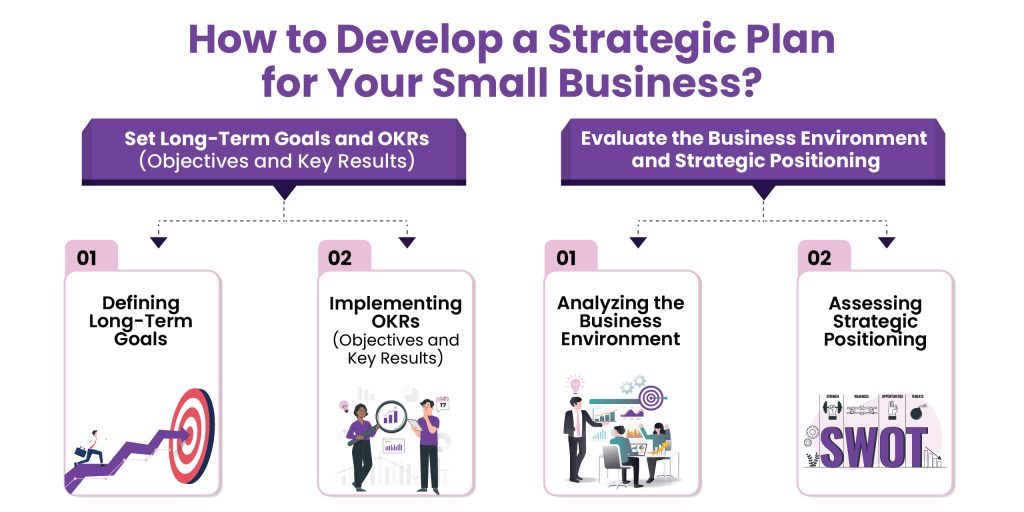
Set Long-Term Goals and OKRs (Objectives and Key Results)
1. Defining Long-Term Goals:
Establish ambitious, yet achievable long-term goals that align with your business’s vision. These goals should provide a clear direction for your organization’s growth over an extended period, usually spanning several years.
Example: Expand our market presence to the Asian-Pacific region and achieve a consistent revenue growth rate of 10% annually within the next five years.
2. Implementing OKRs (Objectives and Key Results):
Objectives: Define specific, measurable, achievable, relevant, and time-bound objectives that support your long-term goals. These should be strategic milestones that help measure progress.
Example: Improve product quality and customer satisfaction to support market share growth.
Key Results: Set key results that are quantifiable and measurable outcomes for each objective. These help in tracking progress and success in achieving the objectives.
Example:
1. Increase customer satisfaction ratings by 20% through surveys and feedback.
2. Achieve a product defect rate of less than 2% through process improvements.
Evaluate the Business Environment and Strategic Positioning
1. Analyzing the Business Environment:
Conduct a thorough analysis of the external factors affecting your business, including market trends, competition, technological advancements, and economic conditions. Understand the opportunities and threats posed by the environment.
Example: Analyze emerging consumer trends, shifts in market demand, and advancements in relevant technologies.
2. Assessing Strategic Positioning:
Strengths: Evaluate your internal strengths, such as expertise, resources, and brand reputation, that can provide a competitive advantage.
Example: Strong brand recognition and a skilled, dedicated workforce.
Weaknesses: Identify internal weaknesses that could hinder your success or growth in the market.
Example: Limited marketing budget and a small product range compared to competitors.
Opportunities: Recognize external opportunities that your business can capitalize on to achieve its strategic goals.
Example: Expanding into a growing, underserved market segment.
Threats: Identify external threats that could potentially harm your business.
Example: Intense competition from well-established market players.
Strategy vs Tactics Examples
Example in a Retail Business

Strategy: Increase market share in the retail industry by targeting a younger demographic through a strong online presence and an engaging in-store experience. This strategy focuses on the ‘what’ and ‘why’ – capturing a larger market share by appealing to a specific audience and improving customer engagement.
Tactics: Implementing specific tactics to achieve this strategy could include launching an e-commerce website, utilizing social media advertising, optimizing the website for mobile devices, creating loyalty programs, and redesigning store layouts for a more interactive and appealing customer experience.
Strategy vs Tactics Example in a Technology Company

Strategy: Establish the company as a leader in innovation within the technology sector by investing heavily in research and development (R&D) and forming strategic partnerships. The strategy here is about positioning the company as an industry innovator, driving growth and influence.
Tactics: The tactics might involve hiring top R&D talent, collaborating with universities for research projects, participating in and sponsoring industry conferences, and engaging in joint ventures with startups for cutting-edge technology integration. These tactics operationalize the strategy, delineating the ‘how’ to achieve the strategic goal.
Strategy vs Tactics Example in a Restaurant Business

Strategy: Establish the restaurant as the go-to destination for health-conscious consumers seeking organic, locally sourced meals. This strategy focuses on the ‘what’ and ‘why’ – appealing to a specific target market and differentiating through a health-conscious approach.
Tactics: Implementing specific tactics, such as creating a menu featuring organic ingredients, partnering with local farmers, marketing campaigns emphasizing health benefits, and offering nutritional information, are the ‘how’ to execute the strategy effectively.
Strategy vs Tactics Example in a Fintech Company

Strategy: Expand the customer base and increase revenue by targeting the millennial market through a user-friendly mobile app for easy investment management. The strategy here is about tapping into a specific market segment and enhancing service accessibility.
Tactics: Tactics would include developing a user-friendly mobile app, integrating features for investment tracking, offering educational content on finance through the app, providing incentives for referrals, and conducting targeted marketing campaigns on social media to reach millennials effectively.
Strategy vs Tactics Example in an Educational Institution

Strategy: Enhance the reputation and ranking of the institution by focusing on academic excellence and research contributions. This strategy aims at positioning the institution as a leading educational and research hub.
Tactics: Tactics might involve hiring renowned faculty, increasing research funding, publishing research findings in reputable journals, establishing research centers, and organizing academic conferences.
Make Design Shifu a part of your strategic and tactical planning
When it comes to small business operations, finding the delicate balance between tactical and strategic planning is paramount for sustained growth and success.
At Design Shifu, we understand the intricate dance between these planning approaches. Our services don’t just stop at providing unparalleled graphic design; we extend our expertise to become an integral part of your strategic and tactical planning.
By collaborating with us, you can infuse creativity seamlessly into your strategies and tactics, ensuring your business stands out amidst the competition.
Explore our plans and let Design Shifu empower your business journey with design brilliance.

